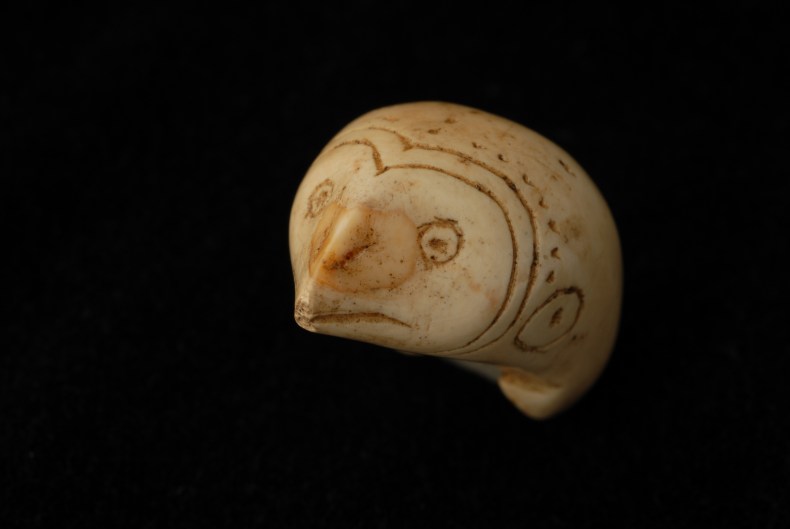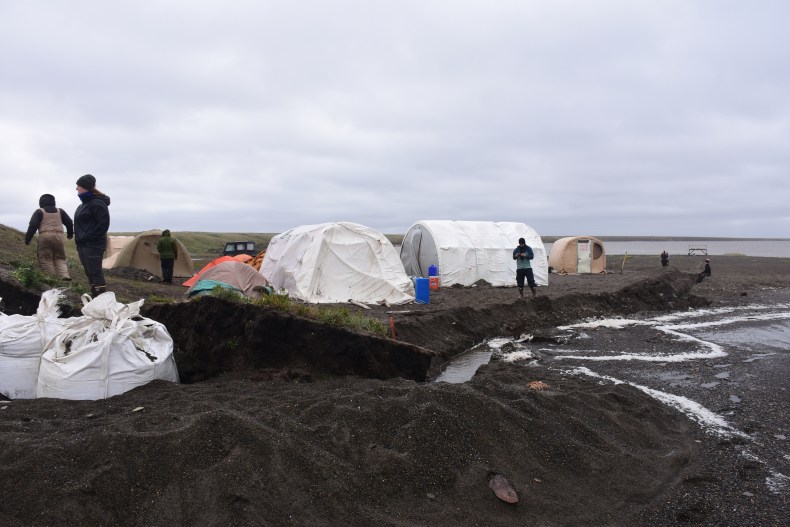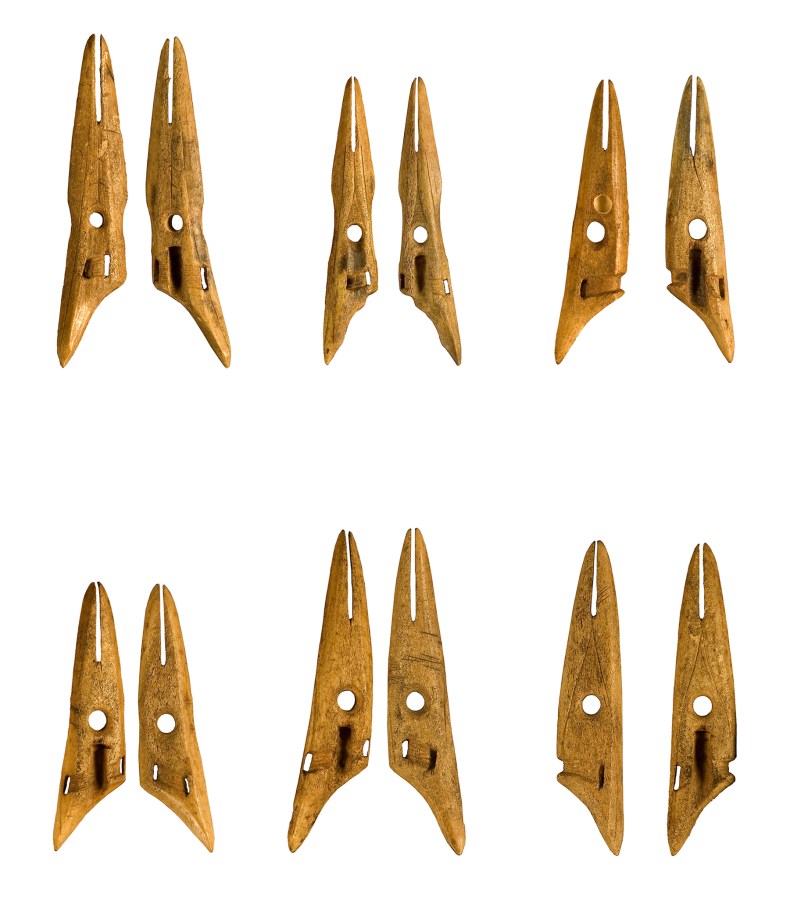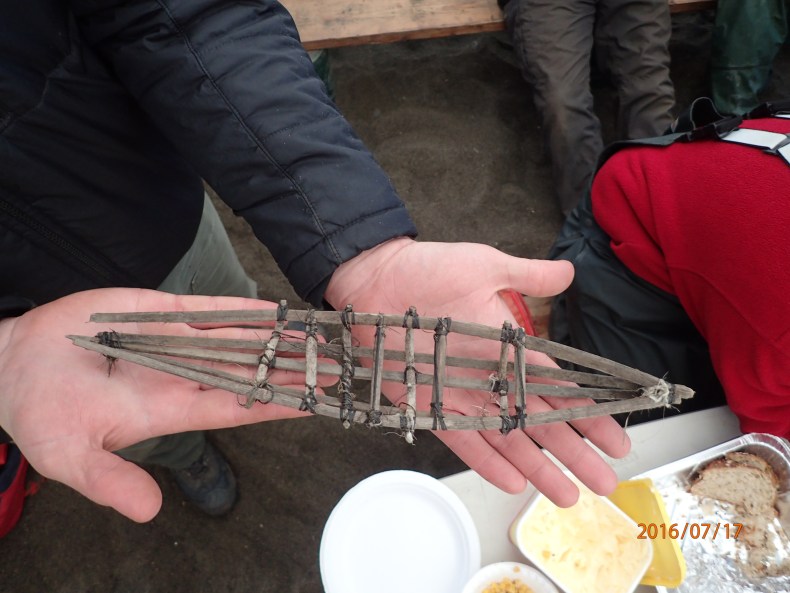Compared to almost anywhere else on the planet, archaeological sites in the polar regions are outstandingly well-preserved, thanks to permafrost – defined as ground that has remained frozen for at least two consecutive years. The preservation of organic material, particularly in sites occupied in the winter, can be almost perfect. Items froze where they were left, and may not have thawed again until recent warmer years. Beyond almost indestructible stone tools, debitage, ceramics, and items made of glass, organic components can make up 95 per cent of the material recovered from these sites, showing what we don’t find in the vast majority of lower-latitude areas: leather goods, whale baleen, ivory carvings, bones and even mummies. While frozen organics do degrade slowly, particularly in well-drained, exposed areas where oxygen and sunlight might reach them, the process at the poles has been extremely slow compared to the rest of the world. Materials known to be hundreds of years old look as well-preserved as items discarded a decade or two before. Agencies like the US National Park Service have had a ‘preservation in place’ policy limiting excavations in such sites.

An ivory toggle in the form of an owl, from a burial at Nuvuk, Alaska, AD 875–1080; courtesy the author
Just as methods to wring ever more information out of organic materials from archaeological sites are maturing, the very existence of those organic artefacts and other materials are threatened by the effects of climate change. While thawing exposes sites that may not otherwise have been easily accessible to archaeologists – if at all – the speed with which thawing is now occurring is too much for their limited resources. Many coastal sites – Walakpa, for example, which could contain material going back at least 4,500 years – are being destroyed, sometimes losing 10m or more in a single storm.

Diverting storm surge on the coast of north Alaska; courtesy the author
Thawing permafrost poses many threats to sites and their contents. Ice-rich permafrost can be well over 50 per cent by volume. When the ice melts and drains there is often serious subsidence or slumping, destroying the site’s integrity. Even when that doesn’t happen, frozen or liquid water helps keep oxygen away from organic materials. Once the oxygen reaches them, they start to degrade. Permafrost also slows bacterial action and various other chemical processes almost to a standstill, similar to putting meat in a freezer. Once the permafrost thaws, these processes speed up, and in some cases can even start generating their own heat, making matters worse. As the active layer (the uppermost thin veneer of soil that thaws every summer) gets deeper due to climate change, it allows plants to develop deeper root systems, and shrubs and trees move into new areas. Plant roots do considerable damage to archaeological sites. This is a new problem for sites close to the poles.
Permafrost helps coastlines and riverbanks resist erosion. As the thawing goes deeper into the banks, and the thaw season gets longer, erosion speeds up. Compounding that is sea-ice retreat. The ice, which used to cover oceans adjacent to polar coasts for all but two or three months a year at most, is now gone for eight months or more in some areas. In 2019, the Alaskan city of Utqiaġvik (formerly Barrow) had open water in February. This leaves the coast exposed to wave action for as much as four times longer each year. Formerly, the ice withdrew 30 miles off shore, often much less, even in late summer. The ice also came right back to the beach off and on throughout the summer. Now it has retreated more than 500 miles from the coast, and is not seen for months on end. This means that storms can transfer much more energy into waves due to the longer fetch. Any given storm will have much bigger waves, with a larger storm surge than would have been the case 20 years ago, resulting in much more damage.

Harpoon heads from a burial at Nuvuk, Alaska; courtesy the author
In addition to being windows into the lives of people in past centuries, sites with good organic preservation are valuable resources for paleo-environmental reconstruction. New techniques let us look at the remains of both people and prey animals in amazing detail. From samples we can study things like ancient DNA (aDNA), which tells us how past and present members of a species are related. If there were population crashes resulting in genetic bottlenecks, aDNA will tell us. We can identify types of food that made up an individual person’s or creature’s diet, telling us where in the food chain animals fell. Isotopes from teeth or bones can reveal where individuals were living and feeding at various stages of life. That, in turn, can tell us about patterns of trade or migration. New techniques are being developed all the time, expanding the kinds of things we can learn from organic remains, just as these remains are seriously threatened.

Wood-and-baleen toy kayak frame, found on the Walakpa beach, north Alaska; courtesy the author
Archaeological sites are repositories of cultural heritage. This includes the cultural heritage of indigenous peoples, many of whom have endured vigorous attempts at Westernisation by colonial powers, resulting in both trauma and cultural loss. Such sites can be instrumental in cultural revitalisation and healing. In the same way that Skara Brae and Angkor Wat are considered part of the cultural heritage of humanity writ large, polar archaeological sites also have a place in our World Heritage. We are all descended from people who lived as hunter-gatherers, and nowhere are hunter-gatherer sites better preserved than in the Arctic. In many other areas, agriculture superseded hunting and gathering long ago. Over the intervening millennia decay has removed all organic material from most of these sites, even those that remained undisturbed. There has been far less building and infrastructure development in the Arctic, helping prevent site disturbance. The polar sites therefore represent a critical source for understanding and preserving humanity’s cultural heritage. Their loss is catastrophic. Given their remote locations, and the high costs of polar logistics, it is unlikely that any of the sites will be protected in place or moved to safety. The only way to save the data, the heritage, is through excavation and recordation. But it’s an overwhelming task, and time is against us.
Lead image: original source U.S. Geological Survey

Polar bare – how climate change is destroying archaeologically rich sites in the Arctic
A collapsed block of ice-rich permafrost at Drew Point, north Alaska. Photo: Benjamin Jones via Wikimedia Commons
Share
Compared to almost anywhere else on the planet, archaeological sites in the polar regions are outstandingly well-preserved, thanks to permafrost – defined as ground that has remained frozen for at least two consecutive years. The preservation of organic material, particularly in sites occupied in the winter, can be almost perfect. Items froze where they were left, and may not have thawed again until recent warmer years. Beyond almost indestructible stone tools, debitage, ceramics, and items made of glass, organic components can make up 95 per cent of the material recovered from these sites, showing what we don’t find in the vast majority of lower-latitude areas: leather goods, whale baleen, ivory carvings, bones and even mummies. While frozen organics do degrade slowly, particularly in well-drained, exposed areas where oxygen and sunlight might reach them, the process at the poles has been extremely slow compared to the rest of the world. Materials known to be hundreds of years old look as well-preserved as items discarded a decade or two before. Agencies like the US National Park Service have had a ‘preservation in place’ policy limiting excavations in such sites.
An ivory toggle in the form of an owl, from a burial at Nuvuk, Alaska, AD 875–1080; courtesy the author
Just as methods to wring ever more information out of organic materials from archaeological sites are maturing, the very existence of those organic artefacts and other materials are threatened by the effects of climate change. While thawing exposes sites that may not otherwise have been easily accessible to archaeologists – if at all – the speed with which thawing is now occurring is too much for their limited resources. Many coastal sites – Walakpa, for example, which could contain material going back at least 4,500 years – are being destroyed, sometimes losing 10m or more in a single storm.
Diverting storm surge on the coast of north Alaska; courtesy the author
Thawing permafrost poses many threats to sites and their contents. Ice-rich permafrost can be well over 50 per cent by volume. When the ice melts and drains there is often serious subsidence or slumping, destroying the site’s integrity. Even when that doesn’t happen, frozen or liquid water helps keep oxygen away from organic materials. Once the oxygen reaches them, they start to degrade. Permafrost also slows bacterial action and various other chemical processes almost to a standstill, similar to putting meat in a freezer. Once the permafrost thaws, these processes speed up, and in some cases can even start generating their own heat, making matters worse. As the active layer (the uppermost thin veneer of soil that thaws every summer) gets deeper due to climate change, it allows plants to develop deeper root systems, and shrubs and trees move into new areas. Plant roots do considerable damage to archaeological sites. This is a new problem for sites close to the poles.
Permafrost helps coastlines and riverbanks resist erosion. As the thawing goes deeper into the banks, and the thaw season gets longer, erosion speeds up. Compounding that is sea-ice retreat. The ice, which used to cover oceans adjacent to polar coasts for all but two or three months a year at most, is now gone for eight months or more in some areas. In 2019, the Alaskan city of Utqiaġvik (formerly Barrow) had open water in February. This leaves the coast exposed to wave action for as much as four times longer each year. Formerly, the ice withdrew 30 miles off shore, often much less, even in late summer. The ice also came right back to the beach off and on throughout the summer. Now it has retreated more than 500 miles from the coast, and is not seen for months on end. This means that storms can transfer much more energy into waves due to the longer fetch. Any given storm will have much bigger waves, with a larger storm surge than would have been the case 20 years ago, resulting in much more damage.
Harpoon heads from a burial at Nuvuk, Alaska; courtesy the author
In addition to being windows into the lives of people in past centuries, sites with good organic preservation are valuable resources for paleo-environmental reconstruction. New techniques let us look at the remains of both people and prey animals in amazing detail. From samples we can study things like ancient DNA (aDNA), which tells us how past and present members of a species are related. If there were population crashes resulting in genetic bottlenecks, aDNA will tell us. We can identify types of food that made up an individual person’s or creature’s diet, telling us where in the food chain animals fell. Isotopes from teeth or bones can reveal where individuals were living and feeding at various stages of life. That, in turn, can tell us about patterns of trade or migration. New techniques are being developed all the time, expanding the kinds of things we can learn from organic remains, just as these remains are seriously threatened.
Wood-and-baleen toy kayak frame, found on the Walakpa beach, north Alaska; courtesy the author
Archaeological sites are repositories of cultural heritage. This includes the cultural heritage of indigenous peoples, many of whom have endured vigorous attempts at Westernisation by colonial powers, resulting in both trauma and cultural loss. Such sites can be instrumental in cultural revitalisation and healing. In the same way that Skara Brae and Angkor Wat are considered part of the cultural heritage of humanity writ large, polar archaeological sites also have a place in our World Heritage. We are all descended from people who lived as hunter-gatherers, and nowhere are hunter-gatherer sites better preserved than in the Arctic. In many other areas, agriculture superseded hunting and gathering long ago. Over the intervening millennia decay has removed all organic material from most of these sites, even those that remained undisturbed. There has been far less building and infrastructure development in the Arctic, helping prevent site disturbance. The polar sites therefore represent a critical source for understanding and preserving humanity’s cultural heritage. Their loss is catastrophic. Given their remote locations, and the high costs of polar logistics, it is unlikely that any of the sites will be protected in place or moved to safety. The only way to save the data, the heritage, is through excavation and recordation. But it’s an overwhelming task, and time is against us.
Lead image: original source U.S. Geological Survey
Unlimited access from just $16 every 3 months
Subscribe to get unlimited and exclusive access to the top art stories, interviews and exhibition reviews.
Share
Recommended for you
Archaeologists discover ancient ceremonial site at Lake Titicaca
Art news daily: 2 April
Venice in furs – an Inuit collective at the Biennale
The Isuma collective’s new film draws on the history of coerced relocation of Inuit communities in Canada
Geometry, pastries and paint: an interview with Wayne Thiebaud
‘I started painting these triangles and turning them into pies. I thought, “My God! I’m done in! Nobody will ever take me seriously!”’